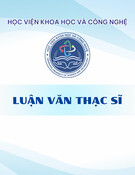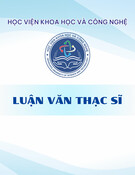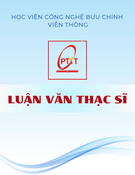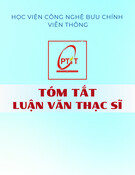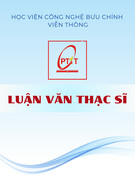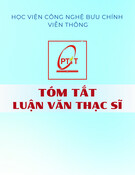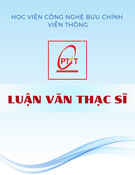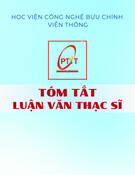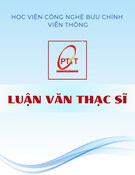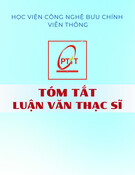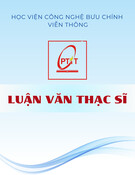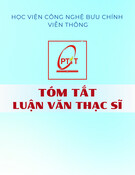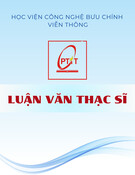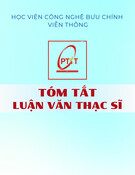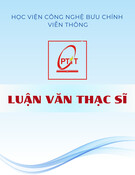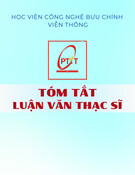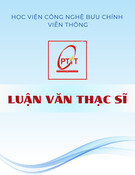
Annals of Mathematics
A new application of random
matrices: Ext(Cred(F2)) is
not a group
By Uffe Haagerup and Steen Thorbjørnsen

Annals of Mathematics,162 (2005), 711–775
A new application of random matrices:
Ext(C∗
red(F2)) is not a group
By Uffe Haagerup and Steen Thorbjørnsen*
Dedicated to the memory of Gert Kjærg˚ard Pedersen
Abstract
In the process of developing the theory of free probability and free entropy,
Voiculescu introduced in 1991 a random matrix model for a free semicircular
system. Since then, random matrices have played a key role in von Neumann
algebra theory (cf. [V8], [V9]). The main result of this paper is the follow-
ing extension of Voiculescu’s random matrix result: Let (X(n)
1,...,X(n)
r)be
a system of rstochastically independent n×nGaussian self-adjoint random
matrices as in Voiculescu’s random matrix paper [V4], and let (x1,...,x
r)be
a semi-circular system in a C∗-probability space. Then for every polynomial p
in rnoncommuting variables
lim
n→∞
pX(n)
1(ω),...,X(n)
r(ω)
=p(x1,...,x
r),
for almost all ωin the underlying probability space. We use the result to
show that the Ext-invariant for the reduced C∗-algebra of the free group on 2
generators is not a group but only a semi-group. This problem has been open
since Anderson in 1978 found the first example of a C∗-algebra Afor which
Ext(A) is not a group.
1. Introduction
A random matrix Xis a matrix whose entries are real or complex ran-
dom variables on a probability space (Ω,F,P). As in [T], we denote by
SGRM(n, σ2) the class of complex self-adjoint n×nrandom matrices
X=(Xij)n
i,j=1,
for which (Xii)i,(
√2ReXij)i<j,(
√2Im Xij)i<j are n2independent identically
distributed (i.i.d.) Gaussian random variables with mean value 0 and vari-
*This work was carried out, while the first author was a member of the MaPhySto –
Centre for Mathematical Physics and Stochastics, funded by the Danish National Research
Foundation. The second author was supported by The Danish National Science Research
Council.

712 UFFE HAAGERUP AND STEEN THORBJ /
ORNSEN
ance σ2. In the terminology of Mehta’s book [Me], Xis a Gaussian unitary
ensemble (GUE). In the following we put σ2=1
nwhich is the normalization
used in Voiculescu’s random matrix paper [V4]. We shall need the following
basic definitions from free probability theory (cf. [V2], [VDN]):
a) A C∗-probability space is a pair (B,τ) consisting of a unital C∗-algebra
Band a state τon B.
b) A family of elements (ai)i∈Iin a C∗-probability space (B,τ) is free if for
all n∈Nand all polynomials p1,...,p
n∈C[X], one has
τ(p1(ai1)···pn(ain))=0,
whenever i1=i2,i
2=i3,...,i
n−1=inand ϕ(pk(aik)) = 0 for k=
1,...,n.
c) A family (xi)i∈Iof elements in a C∗-probability space (B,τ) is a semi-
circular family, if (xi)i∈Iis a free family, xi=x∗
ifor all i∈Iand
τ(xk
i)= 1
2π2
−2
tk4−t2dt=1
k/2+1 k
k/2,if kis even,
0,if kis odd,
for all k∈Nand i∈I.
We can now formulate Voiculescu’s random matrix result from [V5]: Let,
for each n∈N,(X(n)
i)i∈Ibe a family of independent random matrices from the
class SGRM(n, 1
n), and let (xi)i∈Ibe a semicircular family in a C∗-probability
space (B,τ). Then for all p∈Nand all i1,...,i
p∈I,wehave
lim
n→∞ EtrnX(n)
i1···X(n)
ip=τ(xi1···xip),(1.1)
where trnis the normalized trace on Mn(C), i.e., trn=1
nTrn, where Trn(A)
is the sum of the diagonal elements of A. Furthermore, Edenotes expectation
(or integration) with respect to the probability measure P.
The special case |I|= 1 is Wigner’s semi-circle law (cf. [Wi], [Me]). The
strong law corresponding to (1.1) also holds, i.e.,
lim
n→∞ trnX(n)
i1(ω)···X(n)
ip(ω)=τ(xi1···xip),(1.2)
for almost all ω∈Ω (cf. [Ar] for the case |I|= 1 and [HP], [T, Cor. 3.9] for
the general case). Voiculescu’s result is actually more general than the one
quoted above. It also involves sequences of non random diagonal matrices. We
will, however, only consider the case, where there are no diagonal matrices.
The main result of this paper is that the strong version (1.2) of Voiculescu’s
random matrix result also holds for the operator norm in the following sense:
Theorem A.Let r∈Nand,for each n∈N,let (X(n)
1,...,X(n)
r)be a
set of rindependent random matrices from the class SGRM(n, 1
n). Let further

A NEW APPLICATION OF RANDOM MATRICES 713
(x1,...,x
r)be a semicircular system in a C∗-probability space (B,τ)with a
faithful state τ. Then there is a P-null set N⊆Ωsuch that for all ω∈Ω\N
and all polynomials pin rnoncommuting variables,we have
lim
n→∞
pX(n)
1(ω),...,X(n)
r(ω)
=p(x1,...,x
r).(1.3)
The proof of Theorem A is given in Section 7. The special case
lim
n→∞
X(n)
1(ω)
=x1=2
is well known (cf. [BY], [Ba, Thm. 2.12] or [HT1, Thm. 3.1]).
From Theorem A above, it is not hard to obtain the following result
(cf. §8).
Theorem B.Let r∈N∪{∞},let Frdenote the free group on rgenera-
tors,and let λ:Fr→B(ℓ2(Fr)) be the left regular representation of Fr. Then
there exists a sequence of unitary representations πn:Fr→Mn(C)such that
for all h1,...,h
m∈Frand c1,...,c
m∈C:
lim
n→∞
m
j=1
cjπn(hj)
=
m
j=1
cjλ(hj)
.
The invariant Ext(A) for separable unital C∗-algebras Awas introduced
by Brown, Douglas and Fillmore in 1973 (cf. [BDF1], [BDF2]). Ext(A)isthe
set of equivalence classes [π] of one-to-one ∗-homomorphisms π:A→C(H),
where C(H)=B(H)/K(H) is the Calkin algebra for the Hilbert space H=
ℓ2(N). The equivalence relation is defined as follows:
π1∼π2⇐⇒ ∃u∈U(B(H)) ∀a∈A:π2(a)=ρ(u)π1(a)ρ(u)∗,
where U(B(H)) denotes the unitary group of B(H) and ρ:B(H)→C(H) is the
quotient map. Since H⊕H≃H, the map (π1,π
2)→π1⊕π2defines a natural
semi-group structure on Ext(A). By Choi and Effros [CE], Ext(A) is a group
for every separable unital nuclear C∗-algebra and by Voiculescu [V1], Ext(A)
is a unital semi-group for all separable unital C∗-algebras A. Anderson [An]
provided in 1978 the first example of a unital C∗-algebra Afor which Ext(A)is
not a group. The C∗-algebra Ain [An] is generated by the reduced C∗-algebra
C∗
red(F2) of the free group F2on 2 generators and a projection p∈B(ℓ2(F2)).
Since then, it has been an open problem whether Ext(C∗
red(F2)) is a group. In
[V6, Sect. 5.14], Voiculescu shows that if one could prove Theorem B, then it
would follow that Ext(C∗
red(Fr)) is not a group for any r≥2. Hence we have
Corollary 1.Let r∈N∪ {∞},r≥2. Then Ext(C∗
red(Fr)) is not a
group.

714 UFFE HAAGERUP AND STEEN THORBJ /
ORNSEN
The problem of proving Corollary 1 has been considered by a number of
mathematicians; see [V6, §5.11] for a more detailed discussion.
In Section 9 we extend Theorem A (resp. Theorem B) to polynomials
(resp. linear combinations) with coefficients in an arbitrary unital exact C∗-
algebra. The first of these two results is used to provide new proofs of two
key results from our previous paper [HT2]: “Random matrices and K-theory
for exact C∗-algebras”. Moreover, we use the second result to make an exact
computation of the constants C(r), r∈N, introduced by Junge and Pisier [JP]
in connection with their proof of
B(H)⊗
max B(H)=B(H)⊗
min B(H).
Specifically, we prove the following:
Corollary 2.Let r∈N,r≥2, and let C(r)be the infimum of all
real numbers C>0with the following property:There exists a sequence of
natural numbers (n(m))m∈
N
and a sequence of r-tuples (u(m)
1,...,u
(m)
r)m∈
N
of
n(m)×n(m)unitary matrices,such that
r
i=1
u(m)
i⊗¯u(m′)
i
≤C,
whenever m, m′∈Nand m=m′. Then C(r)=2
√r−1.
Pisier proved in [P3] that C(r)≥2√r−1 and Valette proved subsequently
in [V] that C(r)=2
√r−1, when ris of the form r=p+ 1 for an odd prime
number p.
We end Section 9 by using Theorem A to prove the following result on
powers of “circular” random matrices (cf. §9):
Corollary 3.Let Ybe a random matrix in the class GRM(n, 1
n), i.e.,
the entries of Yare independent and identically distributed complex Gaussian
random variables with density z→ n
πe−n|z|2,z∈C. Then for every p∈Nand
almost all ω∈Ω,
lim
n→∞
Y(ω)p
=(p+1)
p+1
pp1
2
.
Note that for p= 1, Corollary 3 follows from Geman’s result [Ge].
In the remainder of this introduction, we sketch the main steps in the
proof of Theorem A. Throughout the paper, we denote by Asa the real vector
space of self-adjoint elements in a C∗-algebra A. In Section 2 we prove the
following “linearization trick”:
Let A,Bbe unital C∗-algebras,and let x1,...,x
rand y1,...,y
rbe opera-
tors in Asa and Bsa,respectively. Assume that for all m∈Nand all matrices

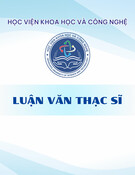
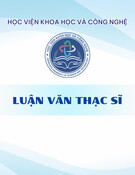
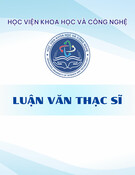
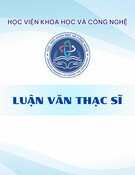
![Luận văn Thạc sĩ: Tổng hợp và đánh giá hoạt tính chống ung thư của hợp phần lai tetrahydro-beta-carboline và imidazo[1,5-a]pyridine](https://cdn.tailieu.vn/images/document/thumbnail/2025/20250816/vijiraiya/135x160/26811755333398.jpg)
